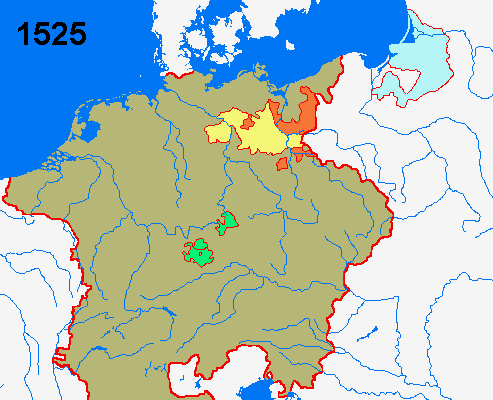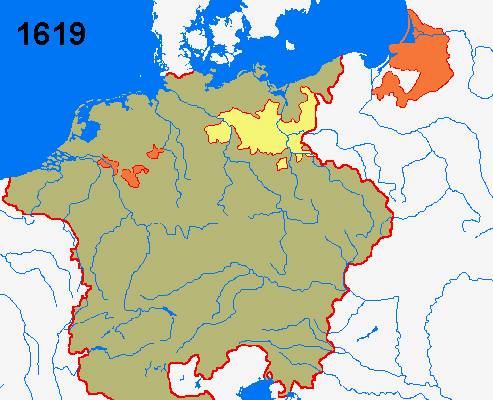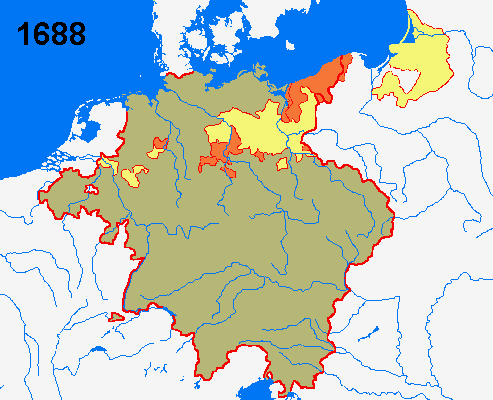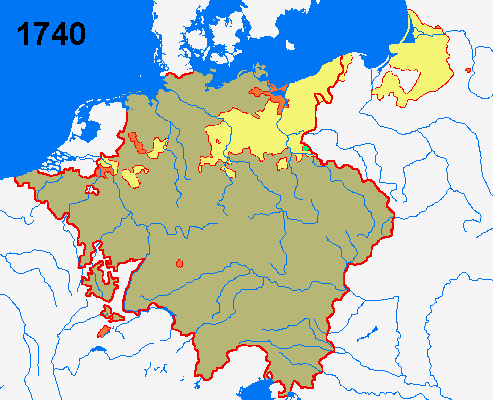|
Brandenburg-Prussia

 = Brandenburg 1415
= Brandenburg 1415
 = Territorial gains
= Territorial gains
 = Temporary possessions
= Temporary possessions
 = Other parts of the Holy Roman Empire
= Other parts of the Holy Roman Empire
 = Duchy of Prussia
= Duchy of Prussia
The margraviate of Brandenburg was created when the Holy
Roman Empire conquered the area in the 12th century. Its first
margrave was Albrecht the Bear who belonged to the house of Askanien, he
and his descendants expanded Brandenburg through marriage, purchase and
war so it became one of the most important principalities in the Holy
Roman Empire. During the 13th century the margrave of
Brandenburg was also elevated to the rank of elector, which meant that he
was one of seven princes that had the right to participate in the election
of the German kings. But when the House of Askanien died out 1319 a period
of decline followed when Brandenburg was a part of the possessions of the
powerful dynasties of Wittelsbach and Luxembourg, during that period the
government of Brandenburg was neglected and its territory decreased.
The turning point came in 1415 when Emperor Sigismund
granted Brandenburg as fief to Friedrich of Hohenzollern. He also
possessed Ansbach and Bayreuth in southern Germany and these areas were
united with Brandenburg 1415-1440 and 1470-1486 but they were lost to
collateral branches of the Hohenzollern dynasty. In Brandenburg the
Hohenzollern electors strengthened the central power and regained
territories that had been lost during the previous period.
Albrekt of Hohenzollern who belonged to a collateral
branch of the dynasty became 1510 Grand Master of the Teutonic Order and
was thereby also regent of the Polish fief Prussia. In 1525 he secularised
the fief and transformed it into a hereditary and Protestant duchy. At the
same time the Protestants were persecuted by Joachim I in Brandenburg ,
but his son Joachim II converted to Protestantism 1539.

 = Brandenburg 1524
= Brandenburg 1524
 = Territorial gains in 1614 and 1618
= Territorial gains in 1614 and 1618
Because of the childless duke Albrecht Friedrich’s
insanity became Brandenburg’s elector Johann Sigismund regent over Prussia
in 1605, and eleven years later he also succeeded Albrecht Friedrich as
duke whereby the historically significant union between Brandenburg and
Prussia was a fact. Before that he had also acquired the duchy of Kleve
and the counties of Mark, Ravensberg and Ravenstein in western Germany. As
a result of these acquisitions the Brandenburg state was now made up of
three separate geographical regions which the following electors and kings
would spend much effort to unite.

 = Brandenburg 1618
= Brandenburg 1618
 = The Great Elector's conquests
= The Great Elector's conquests
Brandenburg held a wavering position during the Thirty
Years’ War 1618-1648 and its territory was therefore ravaged by both
Swedish and Imperial armies. Even though Brandenburg was one of the
largest principalities in the Holy Roman Empire its army was not big and
few could realise how powerful Brandenburg would become during Friedrich
Wilhelm’s reign 1640-1688. He was successful in defending Brandenburg’s
interests at the Peace of Westphalia. He had a legitimate claim to
Swedish-occupied Pomerania but was only given the eastern half, as
compensation for that he obtained the dioceses of Magdeburg, Halberstadt,
Minden and Kammin, although Magdeburg would not be incorporated with
Brandenburg until its administrator died, which happened 1680.
Friedrich Wilhelm, or the Great Elector that he soon came
to be called, spent the years after the Peace of Westphalia rebuilding his
war-torn country. Absolutist rule was introduced gradually in all parts of
the Brandenburg state and a large standing army was raised. In the
Northern War 1655-1660 between Sweden and Poland with allies Brandenburg
once again displayed a wavering position, but this time it was much more
successful and Friedrich Wilhelm managed to obtain sovereignty from Poland
for the duchy of Prussia and gain Polish territory along the border to
Germany.

 = Brandenburg 1688
= Brandenburg 1688
 = Territorial gains
= Territorial gains
 = Territorial loss 1695
= Territorial loss 1695
Fredrich Wilhelm´s son Friedrich III’s reign 1688-1713
fall in the shadows of both his father’s and his son’s reigns, despite of
that it was he who got the emperor’s permission to proclaim himself as
king of Prussia 1701 whereby the Brandenburg state changed its name to
Prussia. Through purchase he expanded this state with Quedlinburg (1698)
and Tecklenburg (1707) and through inheritance after William III of Orange
were the counties of Mörs and Lingen (1702) and Neuchatel with Valangin
(1707) incorporated with Prussia, the latter area was located outside the
Holy Roman Empire in present day Switzerland. The participation in the War
of the Spanish Succession was reworded with a part of Obergeldern in the
Netherlands.
Friedrich’s son Friedrich Wilhelm had unlike his father no
cultural interests, but he was economical and hardworking and under his
reign 1713-1740 the Prussian finances and its agriculture and industry
were greatly improved. Friedrich Wilhelm’s greatest interest lay however
in his army, which was large for a country like Prussia already when he
ascended the throne, in spite of that he increased the army from 38 000
men to 83 000 and drilled it so hard so it became the best in Europe. But
Friedrich Wilhelm preferred peace and participated only in one war, The
Great Northern War 1715-1720, in which he conquered the southern half of
Swedish Pomerania. The history of Prussia continues on the
next page. |

